Today’s CometWatch entry features a new image from Rosetta’s NAVCAM (below) along with a round-up of images released from the OSIRIS narrow- and wide-angle cameras in the last week.
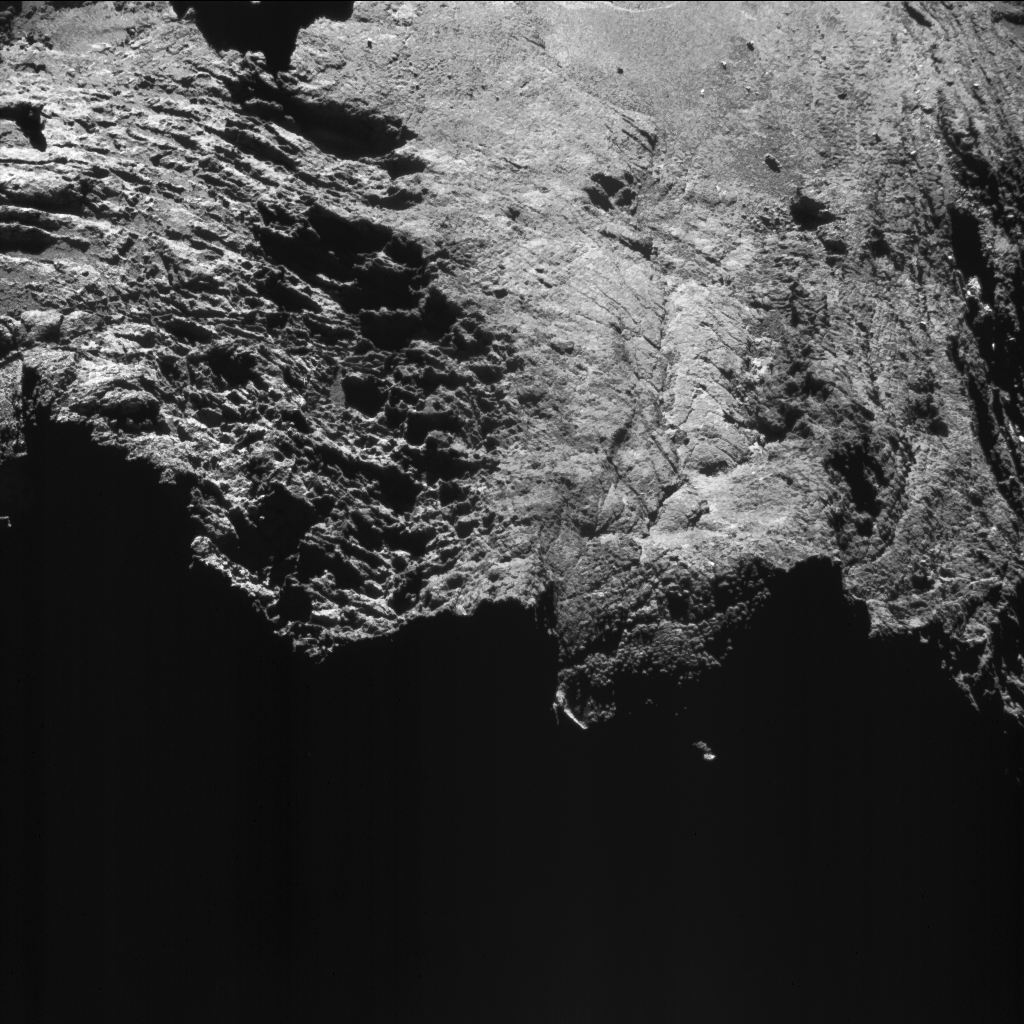
Enhanced NAVCAM image taken from a distance of 10.6 km to the centre of comet 67P/Churyumov-Gerasimenko on 8 August 2016. The image scale is 0.9 m/pixel and the image measures about 930 m across. Credits: ESA/Rosetta/NAVCAM – CC BY-SA IGO 3.0.
The NAVCAM image, taken from a distance of about 10.6 km from Comet 67P/Churyumov-Gerasimenko on 8 August, shows a spectacular close-up of details close to the boundary of Atum (foreground and left) and Anubis (the smoother region towards the top).
To the left, the scene shows exposed layers with smoother material lying in between, which transitions into a heavily eroded zone before taking on a smoother appearance again in the centre, albeit scarred with fracture-like features cross-cutting at a range of scales. Layers can also be picked out towards the top right, some of which have the appearance of being folded, as seen in other images of the Anubis region.
The OSIRIS team have also shared a number of new views via their image of the day website.
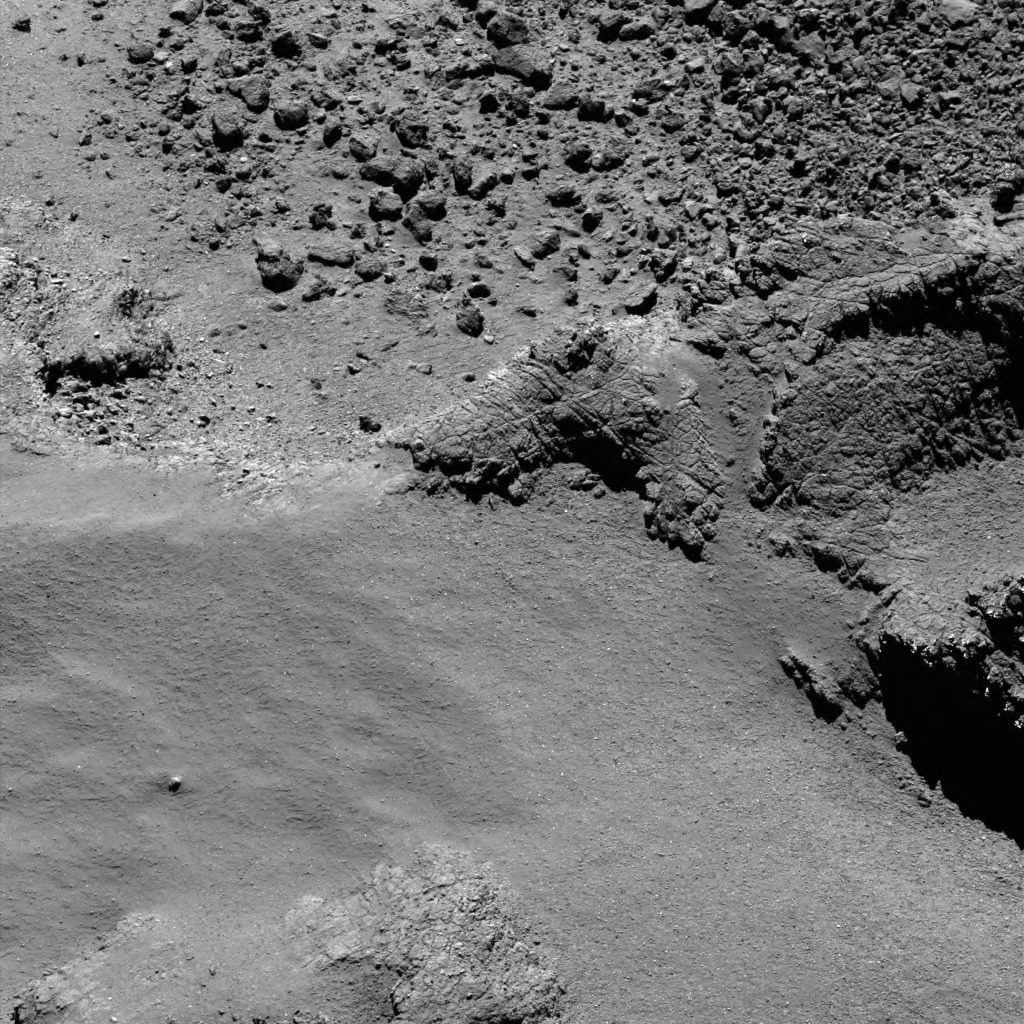
OSIRIS narrow-angle camera image taken on 3 August 2016, when Rosetta was 8.7 km from the centre of Comet 67P/Churyumov–Gerasimenko. The scale is 0.15 m/pixel at the comet and the image measures about 307 m. Credit: ESA/Rosetta/MPS for OSIRIS Team MPS/UPD/LAM/IAA/SSO/INTA/UPM/DASP/IDA
An image captured on 3 August (above) shows a striking contrast between very smooth plains, highly fractured outcrops, and a boulder strewn surface – all within a ~300 x 300 m square region in Seth.
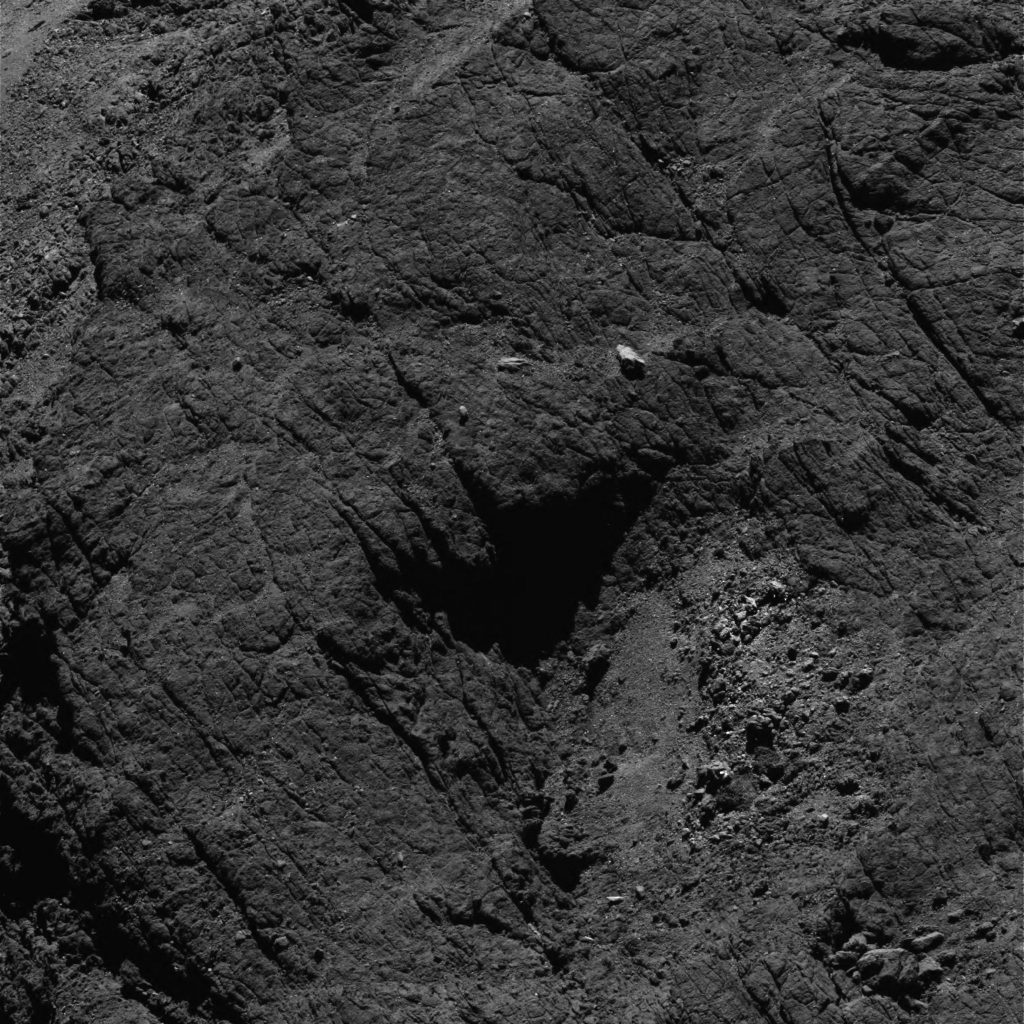
OSIRIS narrow-angle camera image taken on 6 August 2016, when Rosetta was 8.7 km from the centre of Comet 67P/Churyumov–Gerasimenko. The scale is 0.15 m/pixel at the comet and the image measures about 307 m. Credit: ESA/Rosetta/MPS for OSIRIS Team MPS/UPD/LAM/IAA/SSO/INTA/UPM/DASP/IDA
Meanwhile an image captured on 6 August (above) – the two year anniversary of Rosetta arriving at the comet – shows a heavily fractured region in Bastet, on the comet’s small lobe. A relatively smoother patch, home to an array of boulders, sits within the fractured terrain.
Finally, a great view over the large lobe was captured by Rosetta’s OSIRIS wide-angle camera on 10 August (below). It really shows off the curvature of the comet, and the contrasting terrains of Imhotep (left), Khepry and Aten (top/middle) and Ash (right).
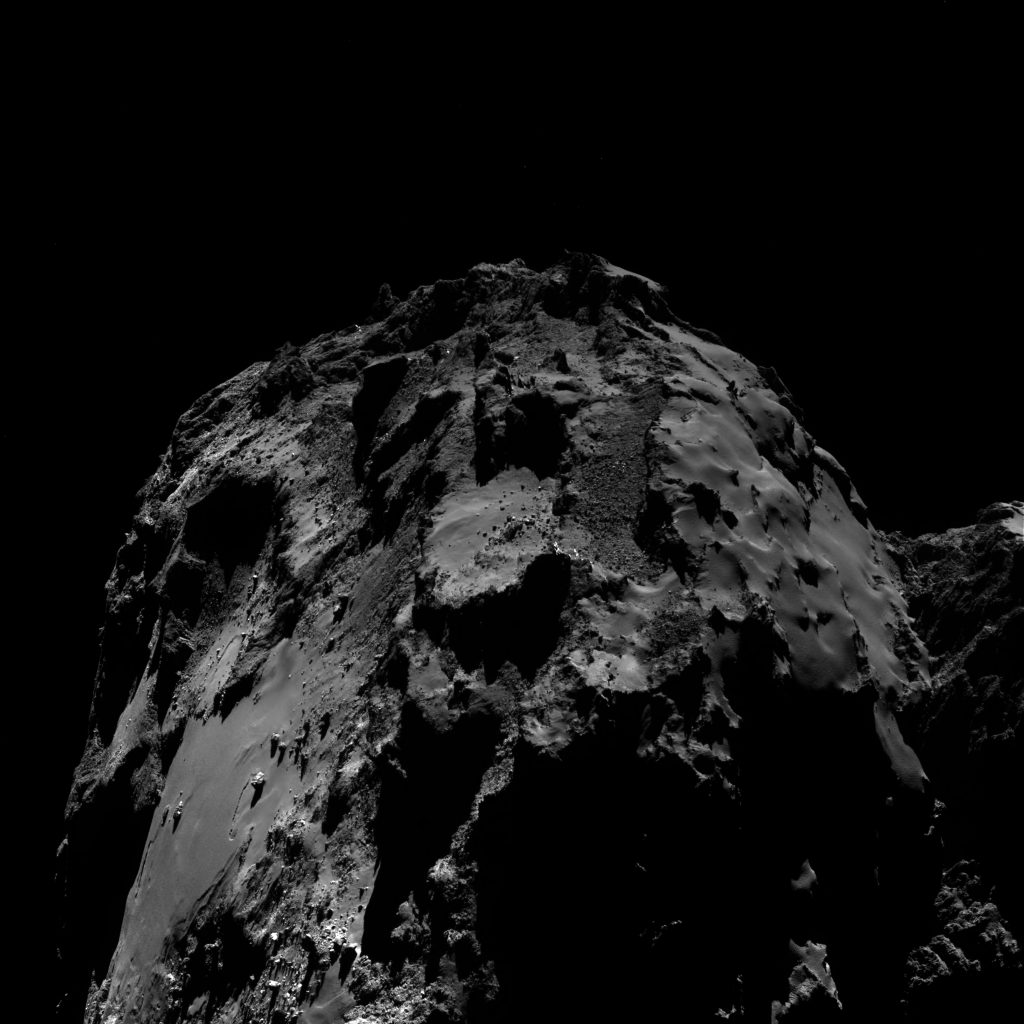
OSIRIS wide-angle camera image taken on 10 August 2016, when Rosetta was 12.8 km from the centre of Comet 67P/Churyumov–Gerasimenko. The scale is 1.18 m/pixel at the comet and the image measures about 2.4 km. Credits: ESA/Rosetta/MPS for OSIRIS Team MPS/UPD/LAM/IAA/SSO/INTA/UPM/DASP/IDA
And in case you missed it…don’t forget our two-year anniversary NAVCAM image here!
The original 1024 x 1024 pixel image of the NAVCAM image released today is provided below:

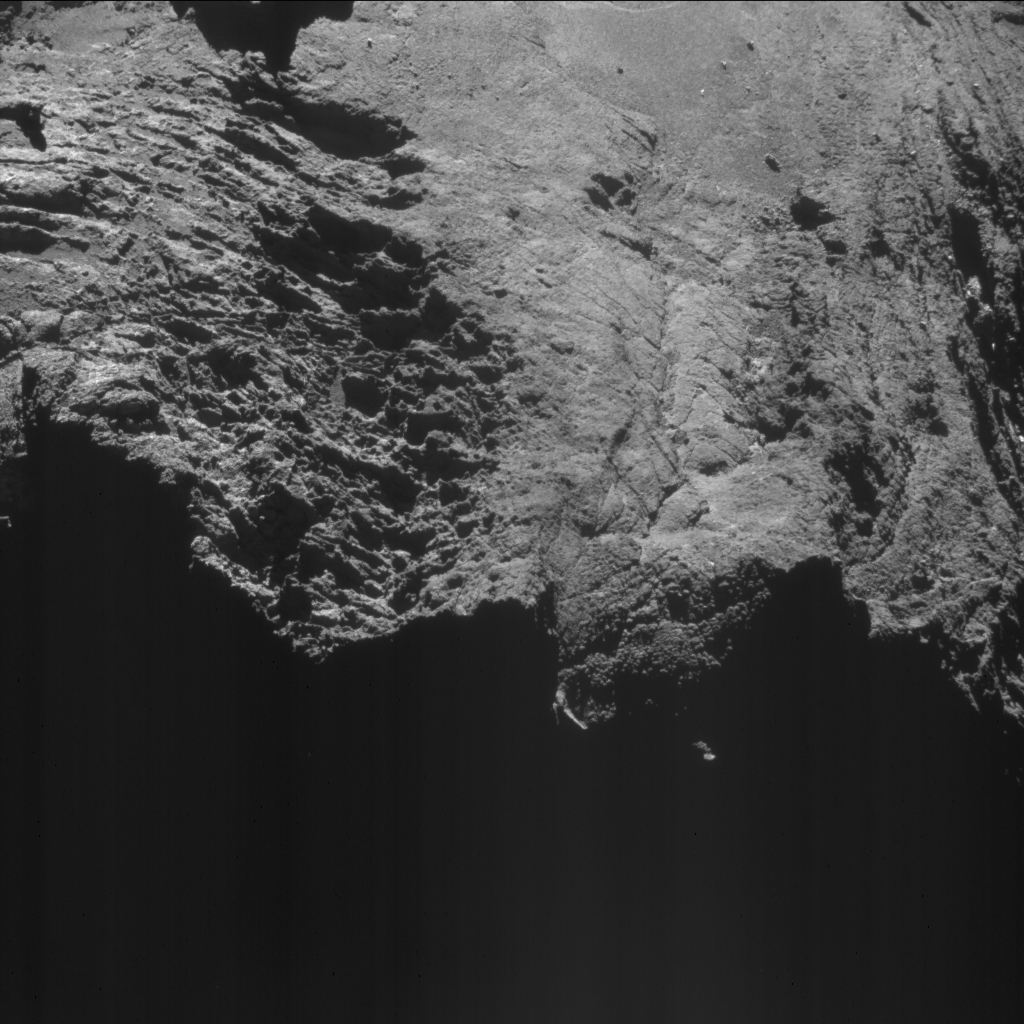








Discussion: 7 comments
‘Disassembling’|’de-graining’ seem more proper terms at this intriguing OSIRIS shot than fracturing|breaking:
https://www.esa.int/spaceinimages/Images/2016/08/Comet_on_3_August_2016_OSIRIS_narrow-angle_camera
Also, the loosed ‘macro-grains’ look so dissimilar. As if mixed shells on a whole cereals store.
Hi Emily
Regarding the first OSIRIS picture above which is this one:
https://m.esa.int/var/esa/storage/images/esa_multimedia/images/2016/08/comet_on_3_august_2016_osiris_narrow-angle_camera/16094323-1-eng-GB/Comet_on_3_August_2016_OSIRIS_narrow-angle_camera_article_mob.jpg
The hump-shaped massif in the middle of the picture appears to have rifted from the larger massif to its right. It’s the section sitting in between the boulder field behind it and the dust field in front it. It slopes and tapers down to the dust on the left and the rift is on the right. The rift is fairly close to vertical in the picture and a bit wavy. It’s about 25 metres wide. As is usually the case, stretch theory can explain its existence in context with its surroundings and the tensile force vectors during stretch. I’ve done a post on it here with lots of explanatory pictures:
https://scute1133site.wordpress.com/2016/08/14/part-53-a-small-rift-in-seth/
Emily
I swivelled the main NAVCAM photo at the top of this post by 90° so that it was in ‘upright duck’ mode with the head lobe above (but out of frame). I saw some interesting things that are almost impossible to see when the photo is side-on.
There’s a 700-metre long wavy feature that has the same profile as another one 300 metres away. The two lines exhibit several small-scale matches which precludes an eroding front of such a distance.
It’s also a translational match across 300 metres with no rotation. So it appears to have slid. I’ve done a post on it:
https://scute1133site.wordpress.com
It’s rather telling that the upper line is contiguous with the edge of three trays which I’ve identified as the head lobe shear line. This is according to stretch theory which is not accepted by the Rosetta mission. That’s my standard occasional caveat for any readers here who are only interested in peer reviewed literature.
The three trays are the ones from which three nominally scalloped features on the head rim broke away. I’ve matched the trays to the scallops at least three times in comments on the Rosetta blog over the last year and they’ve been done on photos from completely different viewpoints. After the first one, Harvey said it might not hold up from another viewpoint. On the second one, Gerald said much the same thing. On the third one, six months back there was no comment.
Now it appears that the apparent seating for this 300-metre crust slide is not only contiguous with the former head/3-scallop seating on the body but its present day position dictates that the slide must have been in the exact opposite direction to the hypothesised head lobe lift-off at the shear line. This is consistent with all such purported slides discovered to date. It’s also consistent with the tensile force vectors in a stretching comet. This is why I’ve said that all such explanations in stretch theory are complementary to their neighbouring regions as dictated by the constraints of the tensile force vectors during stretch.
A.Cooper: I found the upright duck from Part 54 (Atum crust) with the matches you point out striking. Sliding ices underneath is an ingenious explanation. Suppose some reasonably large amount of ices (tens or hundreds of metres) sublimate, in some explosive event. What would be the response in the ice in the neighbouring region? Not clear to me that sliding might happen, I think we know relatively little about material inside a comet nucleus.
A. Cooper: Cometwatch 11 September (Navcam image) and the Osiris image taken on 17 September both suggest sliding.
The clean [thermal?] wound at left side of this image suggest that the safest bet for any small particle loosening or breaking from 67P core, is departure…
https://www.esa.int/spaceinimages/Images/2016/08/Comet_on_8_August_2016_NavCam